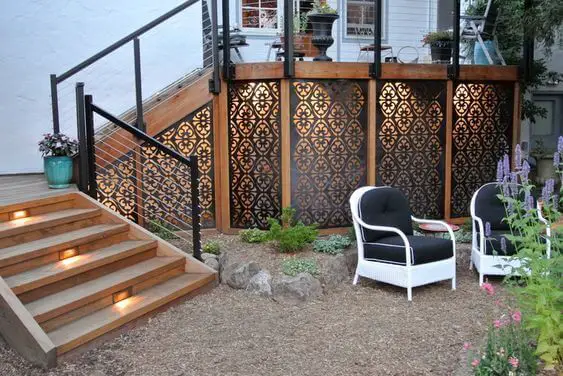Planning a kitchen garden can be a fun and rewarding experience, as it allows you to grow fresh fruits and vegetables while adding a beautiful and functional element to your outdoor space. Moreover, it can be a great way to enhance the beauty and productivity of your outdoor space while also providing fresh, healthy produce for your family.
A kitchen garden allows you to grow your own fresh produce, which can be healthier and more flavorful than store-bought produce. Growing your own food reduces your carbon footprint and promotes sustainability. In addition, growing your own food can save you money on groceries. A well-designed kitchen garden can add beauty and interest to your outdoor space. Do not miss a great opportunity to learn about gardening, plants, and sustainability when you plan and design a kitchen garden.
- Determine the size and location of your garden. Consider factors such as sunlight exposure, soil quality, and water availability when choosing a location for your garden. Choose a location that receives at least six hours of sunlight per day and has well-draining soil. Consider the proximity to your home, access to water, and any obstructions such as trees or buildings.
- Assess your needs and preferences. Think about what fruits and vegetables you and your family enjoy eating and select plants that will thrive in your local climate and soil. Consider factors such as the size of your garden, the amount of sunlight it receives, your climate, and the types of plants you enjoy. This will ensure that your garden is productive, sustainable, and enjoyable.
- Create a plan. Draw a rough sketch of your garden and include details such as the location of plants, paths, and garden beds. Decide on the size and shape of your garden and plan the layout of beds, paths, and other features. Consider using raised beds or containers to make the garden more accessible and easier to maintain.
- A comfortable seating area- When designing a kitchen garden, ensure that there is adequate room for the seating area. Consider adding outdoor furniture that is weather-resistant and comfortable, such as a bench or chairs, to create a cozy and inviting space for relaxation and enjoyment. You can use recycled plastic seating to do your bit for the environment and look for other options that can seamlessly work into the idea.
- Choose the right plants. Select plants that will complement each other in terms of growth habits, sunlight needs, and water requirements. Choose plants that are suitable for your climate and soil type and that you and your family enjoy eating. Consider factors such as the plant’s growth habits, height, and spacing requirements.
- Plan for proper drainage. Proper drainage is essential for the health and productivity of a kitchen garden. Without adequate drainage, plants can become waterlogged and susceptible to disease. Consider incorporating features such as raised beds or drainage systems to prevent water buildup. Make sure that the soil in your garden beds is well-draining to prevent waterlogged roots.
- Incorporate raised beds. Raised beds can be a great option for a kitchen garden, as they provide good drainage, improved soil quality, and ease of access for planting and maintenance. When designing raised beds, consider the size, height, and materials, and ensure that they are properly leveled and filled with high-quality soil to promote healthy plant growth.
- Consider using companion planting. Companion planting is a gardening technique in which different plants are grown together to benefit each other’s growth. Companion planting is the practice of planting complementary plants together to improve growth and deter pests. Research companion planting to find combinations that work well for the plants you have chosen.
- Add paths and walkways. This will make it easy to access all areas of your garden and also helps to keep the soil from becoming compact. Consider the size, shape, and materials of paths and walkways, and ensure they are wide enough for comfortable passage and easy maintenance. Incorporating permeable materials can also help with drainage and water conservation.
- Provide proper irrigation: Choose a watering method that is appropriate for your climate and plants, such as drip irrigation or a sprinkler system. . Install an irrigation system to ensure that your plants receive the right amount of water at the right time. Monitor soil moisture levels regularly and adjust watering as needed to ensure that plants receive the right amount of water for optimal growth.
- Incorporate vertical gardening. Vertical gardening can maximize space in your garden and also adds visual interest. Choose suitable plants for vertical growth, such as climbers or vining vegetables, and install supports such as trellises or stakes. Ensure adequate soil, light, and water for healthy plant growth, and monitor for pests and diseases regularly.
- Create a focal point. Add a feature such as a trellis or an arbor to draw the eye and create a sense of structure in your garden. Consider incorporating a centerpiece, such as a sculpture or fountain, or a feature that attracts pollinators and wildlife, such as a butterfly garden or birdhouse. Ensure that the focal point is well-placed and proportionate to the size of the garden.
- Incorporate a compost area and use mulch. Composting is a great way to recycle kitchen scraps and yard waste and provides a natural fertilizer source for your garden. Use mulch. Mulch can help retain moisture in the soil, suppress weeds, and add a finished look to your garden.
- Provide shade and lighting . Make sure your plants receive the appropriate shade by installing shading structures, such as pergolas or shade cloths. Add lighting to your garden to extend the time you can spend in it and also to highlight specific features.
- Think about maintenance. Consider the maintenance needs of your garden and make sure that you have the time and resources to properly care for it. Tasks such as weeding, pruning, and fertilizing should be done regularly to prevent pests and diseases and ensure healthy plant growth.
When designing your kitchen garden, it’s important to consider the size and location of your garden, as well as your needs and preferences. Create a plan and select plants that will complement each other in terms of growth habits, sunlight needs, and water requirements. Proper drainage and irrigation are essential, as are raised beds, companion planting, paths and walkways, vertical gardening, and a focal point. A compost area, mulch, shade, and lighting can also be incorporated to help make the garden look beautiful and functional. Maintenance is also important to consider, and ensure you have the time and resources to properly take care of it. With these tips in mind, you’ll be well on your way to designing a beautiful and productive kitchen garden.





